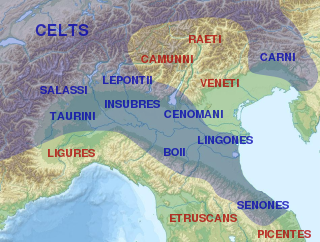Related Research Articles

The Taurini were a Celto-Ligurian tribe dwelling in the upper valley of the river Po, around present-day Turin, during the Iron Age and the Roman period.
The Viducassēs were a Gallic tribe dwelling in the modern Calvados department during the Iron Age and the Roman period.
The Deciates (Δεκιήταις) were a Ligurian tribe dwelling near on the Mediterranean coast, around present-day Antibes, during the Iron Age and the Roman era.
The Oxybii or Oxubii were a Celto-Ligurian tribe dwelling on the Mediterranean coast during the Iron Age and the Roman period.
The Medulli were a Gallic tribe dwelling in the upper valley of Maurienne, around present-day Modane (Savoie), during the Iron Age and Roman period.
The Latobici or Latovici were a Celtic tribe dwelling in Pannonia Superior, around present-day Drnovo (Slovenia), during the Roman period.
The Tricastini were a small Gallic tribe dwelling in the modern Tricastin region, near present-day Saint-Paul-Trois-Châteaux, during the Iron Age and the Roman period.
The Vediantii were a Celto-Ligurian tribe dwelling on the Mediterranean coast, near present-day Nice, during the Iron Age and the Roman period.
The Ingauni were a Celto-Ligurian tribe dwelling on the Mediterranean coast, around the modern city of Albenga (Liguria), during the Iron Age and the Roman period.
The Nemeturii or Nemeturi were a Gallic tribe dwelling in the Alpes Maritimae during the Iron Age.
The Venisami or Venisamores were a Gallic tribe dwelling in the Alps during the Iron Age.
The Ambisontes were a Gallic tribe dwelling in the upper Salzach valley during the Roman period.
The Sogionti or Sogiontii were a Gallic tribe dwelling around present-day Sisteron during the Iron Age.
The Rucinates or Rucantii were a Gallic tribe dwelling in near the confluence of the Isar and Danube rivers during the Roman period.
The Ambilici were a Gallic tribe dwelling in the valley of Gail river during the Roman period.
The Catenates or Cattenates were a Gallic tribe dwelling between the Isar and Inn rivers during the Iron Age.
The Licates were a Gallic tribe dwelling in the upper valley of the Lech river during the Iron Age and the Roman period.
The Ligauni were a Celto-Ligurian tribe dwelling near the Mediterranean coast during the Iron Age and the Roman period.
The Brixentes or Brixenetes were a Celtic or Rhaetian tribe living in the Alps during the Iron Age and the Roman era.
The Anatilii were a Gallic tribe dwelling in the Alpilles region during the Iron Age.
References
- ↑ Polybius. Historíai, 2:17:4.
- ↑ Livy. Ab Urbe Condita Libri, 5:35:1-2.
- ↑ Pliny. Naturalis Historia, 3:124; 3:37.
- ↑ Ptolemy. Geōgraphikḕ Hyphḗgēsis, 3:1:32.
- ↑ Falileyev 2010, s.v. Libicii.
- ↑ de Bernardo Stempel 2000, p. 107.
- ↑ Barruol 1969, p. 159.
- ↑ Talbert 2000, Map 15: Arelate-Massalia.
- 1 2 Barruol 1969, pp. 192–193.
- ↑ Barruol 1969, pp. 187–188.
